Dual-Emissive Rectangular Supramolecular Pt(II)-p-Biphenyl with 4,4′-Bipyridine Derivative Metallacycles: Stepwise Synthesis and Photophysical Properties
Abstract
:1. Introduction
2. Results and Discussion
2.1. Synthesis and Characterization
2.2. Crystal Structure of Complex 8
2.3. Photophysical Studies
2.3.1. Absorption and Emission Spectra of (8)–(10)
2.3.2. Solvent Effect on Emission Spectra of (8)–(10)
2.3.3. Aggregation Effect and Emission Bimodal Spectra of (9) and (10)
3. Experiment
3.1. Materials and Methods
3.2. Fluorescence Emission Studies
3.3. X-ray Crystallography
3.4. Synthesis of the Complexes (2)–(10)
4. Conclusions
Supplementary Materials
Author Contributions
Funding
Institutional Review Board Statement
Informed Consent Statement
Data Availability Statement
Acknowledgments
Conflicts of Interest
Sample Availability
References
- Saygili, Y.; Stojanovic, M.; Flores-Díaz, N.; Zakeeruddin, S.M.; Vlachopoulos, N.; Grätzel, M.; Hagfeldt, A. Metal coordination complexes as redox mediators in regenerative dye-sensitized solar cells. Inorganics 2019, 7, 30. [Google Scholar] [CrossRef]
- Grifoni, F.; Bonomo, M.; Naim, W.; Barbero, N.; Alnasser, T.; Dzeba, I.; Giordano, M.; Tsaturyan, A.; Urbani, M.; Torres, T.; et al. Toward Sustainable, Colorless, and Transparent Photovoltaics: State of the Art and Perspectives for the Development of Selective Near-Infrared Dye-Sensitized Solar Cells. Adv. Energy Mater. 2021, 11, 2101598. [Google Scholar] [CrossRef]
- Bizzarri, C.; Spuling, E.; Knoll, D.M.; Volz, D.; Bräse, S. Sustainable metal complexes for organic light-emitting diodes (OLEDs). Coord. Chem. Rev. 2018, 373, 49–82. [Google Scholar] [CrossRef]
- Zhang, Q.C.; Xiao, H.; Zhang, X.; Xu, L.J.; Chen, Z.N. Luminescent oligonuclear metal complexes and the use in organic light-emitting diodes. Coord. Chem. Rev. 2019, 378, 121–133. [Google Scholar] [CrossRef]
- Zhang, L.; Humphrey, M.G. Multiphoton absorption at metal alkynyl complexes. Coord. Chem. Rev. 2022, 473, 214820. [Google Scholar] [CrossRef]
- Colombo, A.; Dragonetti, C.; Guerchais, V.; Hierlinger, C.; Zysman-Colman, E.; Roberto, D. A trip in the nonlinear optical properties of iridium complexes. Coord. Chem. Rev. 2020, 414, 213293. [Google Scholar] [CrossRef]
- Ning, Y.; Jin, G.Q.; Wang, M.X.; Gao, S.; Zhang, J.L. Recent progress in metal-based molecular probes for optical bioimaging and biosensing. Curr. Opin. Chem. Biol. 2022, 66, 102097. [Google Scholar] [CrossRef]
- Lee, L.C.; Lo, K.K. Strategic Design of Luminescent Rhenium(I), Ruthenium(II), and Iridium(III) Complexes as Activity-Based Probes for Bioimaging and Biosensing. Chem. Asian J. 2022, 17, e202200840. [Google Scholar] [CrossRef]
- Dey, N.; Haynes, C.J.E. Supramolecular Coordination Complexes as Optical Biosensors. Chempluschem 2021, 86, 418–433. [Google Scholar] [CrossRef]
- Fujita, M.; Yazaki, J.; Ogura, K. Preparation of a macrocyclic polynuclear complex, [(en)Pd(4,4′-bpy)]4(NO3)8 (en = ethylenediamine, bpy = bipyridine), which recognizes an organic molecule in aqueous media. J. Am. Chem. Soc. 1990, 112, 5645–5647. [Google Scholar] [CrossRef]
- Stang, P.J.; Whiteford, J.A. Mixed, Neutral-Charged, Platinum-Platinum and Platinum-Palladium Macrocyclic Tetranuclear Complexes. Organometallics 1994, 13, 3776–3777. [Google Scholar] [CrossRef]
- Chakrabarty, R.; Mukherjee, P.S.; Stang, P.J. Supramolecular Coordination: Self-Assembly of Finite Two- and Three-Dimensional Ensembles. Chem. Rev. 2011, 111, 6810–6918. [Google Scholar] [CrossRef]
- Holliday, B.J.; Mirkin, C.A. Strategies for the Construction of Supramolecular Compounds through Coordination Chemistry. Angew. Chem. Int. Ed. 2001, 40, 2022–2043. [Google Scholar] [CrossRef]
- Fujita, M.; Yazaki, J.; Ogura, K. Spectroscopic Observation of Self-Assembly of a Macrocyclic Tetranuclear Complex Composed of Pt 2+ and 4,4′-Bipyridine. Chem. Lett. 1991, 20, 1031–1032. [Google Scholar] [CrossRef]
- Orita, A.; Jiang, L.; Nakano, T.; Ma, N.; Otera, J. Solventless reaction dramatically accelerates supramolecular self-assembly. Chem. Commun. 2002, 2, 1362–1363. [Google Scholar] [CrossRef]
- Stang, P.J.; Cao, D.H. Transition Metal Based Cationic Molecular Boxes. Self-Assembly of Macrocyclic Platinum(II) and Palladium(II) Tetranuclear Complexes. J. Am. Chem. Soc. 1994, 116, 4981–4982. [Google Scholar] [CrossRef]
- Garci, A.; Castor, K.J.; Fakhoury, J.; Do, J.L.; Di Trani, J.; Chidchob, P.; Stein, R.S.; Mittermaier, A.K.; Friščić, T.; Sleiman, H. Efficient and Rapid Mechanochemical Assembly of Platinum(II) Squares for Guanine Quadruplex Targeting. J. Am. Chem. Soc. 2017, 139, 16913–16922. [Google Scholar] [CrossRef] [PubMed]
- Ferrer, M.; Pedrosa, A.; Rodríguez, L.; Rossell, O.; Vilaseca, M. New insights into the factors that govern the square/triangle equilibria of Pd(II) and Pt(II) supramolecules. Unexpected participation of a mononuclear species in the equilibrium. Inorg. Chem. 2010, 49, 9438–9449. [Google Scholar] [CrossRef] [PubMed]
- Ferrer, M.; Gutiérrez, A.; Mounir, M.; Rossell, O.; Ruiz, E.; Rang, A.; Engeser, M. Self-assembly reactions between the cis-protected metal corners (N-N)M II (N-N = ethylenediamine, 4,4′-substituted 2,2′-bipyridine; M = Pd, Pt) and the fluorinated edge 1,4-bis(4-pyridyl) tetrafluorobenzene. Inorg. Chem. 2007, 46, 3395–3406. [Google Scholar] [CrossRef]
- Rang, A.; Nieger, M.; Engeser, M.; Lützen, A.; Schalley, C.A. Self-assembling squares with amino acid-decorated bipyridines: Heterochiral self-sorting of dynamically interconverting diastereomers. Chem. Commun. 2008, 4789–4791. [Google Scholar] [CrossRef]
- Zheng, Y.R.; Zhao, Z.; Wang, M.; Ghosh, K.; Pollock, J.B.; Cook, T.R.; Stang, P.J. A facile approach toward multicomponent supramolecular structures: Selective self-assembly via charge separation. J. Am. Chem. Soc. 2010, 132, 16873–16882. [Google Scholar] [CrossRef] [PubMed]
- Lusby, P.J.; Müller, P.; Pike, S.J.; Slawin, A.M.Z. Stimuli-responsive reversible assembly of 2D and 3D metallosupramolecular architectures. J. Am. Chem. Soc. 2009, 131, 16398–16400. [Google Scholar] [CrossRef] [PubMed]
- Iwamoto, T.; Watanabe, Y.; Sakamoto, Y.; Suzuki, T.; Yamago, S. Selective and Random Syntheses of [n]Cycloparaphenylenes (n = 8–13) and Size Dependence of Their Electronic Properties. J. Am. Chem. Soc. 2011, 133, 8354–8361. [Google Scholar] [CrossRef] [PubMed]
- Cui, S.; Zhuang, G.; Wang, J.; Huang, Q.; Wang, S.; Du, P. Multifunctionalized octamethoxy-[8]cycloparaphenylene: Facile synthesis and analysis of novel photophysical and photoinduced electron transfer properties. Org. Chem. Front. 2019, 6, 1885–1890. [Google Scholar] [CrossRef]
- Lucas, F.; Sicard, L.; Jeannin, O.; Rault-Berthelot, J.; Jacques, E.; Quinton, C.; Poriel, C. [4]Cyclo-N-ethyl-2,7-carbazole: Synthesis, Structural, Electronic and Charge Transport Properties. Chem. A Eur. J. 2019, 25, 7740–7748. [Google Scholar] [CrossRef]
- Sun, Z.; Sarkar, P.; Suenaga, T.; Sato, S.; Isobe, H. Belt-Shaped Cyclonaphthylenes. Angew. Chem. 2015, 127, 12991–12995. [Google Scholar] [CrossRef]
- Yamamoto, T.; Wakabayashi, S.; Osakada, K. Mechanism of C C coupling reactions of aromatic halides, promoted by Ni(COD)2 in the presence of 2,2′-bipyridine and PPh3, to give biaryls. J. Organomet. Chem. 1992, 428, 223–237. [Google Scholar] [CrossRef]
- Zheng, X.H.; Chen, H.Y.; Tong, M.L.; Ji, L.N.; Mao, Z.W. Platinum squares with high selectivity and affinity for human telomeric G-quadruplexes. Chem. Commun. 2012, 48, 7607–7609. [Google Scholar] [CrossRef]
- Kumazawa, K.; Biradha, K.; Kusukawa, T.; Okano, T.; Fujita, M. Multicomponent assembly of a pyrazine-pillared coordination cage that selectively binds planar guests by intercalation. Angew. Chem. Int. Ed. 2003, 42, 3909–3913. [Google Scholar] [CrossRef]
- Bruce, M.I.; Costuas, K.; Halet, J.F.; Hall, B.C.; Low, P.J.; Nicholson, B.K.; Skeltone, B.W.; White, A.H. Preparation of buta-1,3-diynyl complexes of platinum(II) and their use in the construction of neutral molecular squares: Synthesis, structural and theoretical characterisation of cyclo-{Pt(μ-C≡CC≡C)(dppe)}4 and related chemistry. J. Chem. Soc. Dalton Trans. 2002, 383–398. [Google Scholar] [CrossRef]
- Janka, M.; Anderson, G.K.; Rath, N.P. Synthesis of neutral molecular squares composed of bis(phosphine)platinum corner units and dialkynyl linkers. Solid-state characterization of [Pt(μ-C≡CC≡C)(dppp)] 4. Organometallics 2004, 23, 4382–4390. [Google Scholar] [CrossRef]
- Stang, P.J.; Fan, J.; Olenyuk, B. Molecular architecture via coordination: Self-assembly of cyclic cationic porphyrin aggregates via transition-metal bisphosphane auxiliaries. Chem. Commun. 1997, 1453–1454. [Google Scholar] [CrossRef]
- Würthner, F.; Sautter, A. Highly fluorescent and electroactive molecular squares containing perylene bisimide ligands. Chem. Commun. 2000, 2, 445–446. [Google Scholar] [CrossRef]
- Stang, P.J.; Olenyuk, B. Directed Self-Assembly of Chiral, Optically Active Macrocyclic Tetranuclear Molecular Squares. Angew. Chem. Int. Ed. Engl. 1996, 35, 732–736. [Google Scholar] [CrossRef]
- Gupta, G.; You, Y.; Hadiputra, R.; Jung, J.; Kang, D.K.; Lee, C.Y. Heterometallic bodipy-based molecular squares obtained by self-assembly: Synthesis and biological activities. ACS Omega 2019, 4, 13200–13208. [Google Scholar] [CrossRef]
- Yang, H.-B.; Das, N.; Huang, F.; Hawkridge, A.M.; Díaz, D.D.; Arif, A.M.; Finn, M.G.; Muddiman, D.C.; Stang, P.J. Incorporation of 2,6-Di(4,4′-dipyridyl)-9-thiabicyclo[3.3.1]nonane into Discrete 2D Supramolecules via Coordination-Driven Self-Assembly. J. Org. Chem. 2006, 71, 6644–6647. [Google Scholar] [CrossRef]
- Pollock, J.B.; Schneider, G.L.; Cook, T.R.; Davies, A.S.; Stang, P.J. Tunable Visible Light Emission of Self-Assembled Rhomboidal Metallacycles. J. Am. Chem. Soc. 2013, 135, 13676–13679. [Google Scholar] [CrossRef]
- Grishagin, I.V.; Pollock, J.B.; Kushal, S.; Cook, T.R.; Stang, P.J.; Olenyuk, B.Z. In vivo anticancer activity of rhomboidal Pt(II) metallacycles. Proc. Natl. Acad. Sci. USA 2014, 111, 18448–18453. [Google Scholar] [CrossRef]
- Pollock, J.B.; Cook, T.R.; Stang, P.J. Photophysical and Computational Investigations of Bis(phosphine) Organoplatinum(II) Metallacycles. J. Am. Chem. Soc. 2012, 134, 10607–10620. [Google Scholar] [CrossRef]
- Chen, J.-S.; Zhao, G.-J.; Cook, T.R.; Han, K.-L.; Stang, P.J. Photophysical Properties of Self-Assembled Multinuclear Platinum Metallacycles with Different Conformational Geometries. J. Am. Chem. Soc. 2013, 135, 6694–6702. [Google Scholar] [CrossRef]
- Fan, Y.; Zhang, J.; Li, Y.; Chen, Q.; Ni, Z.; Zhou, H.; Yu, J.; Qiu, H.; Yin, S. Amphiphilic rhomboidal metallacycles with aggregation-induced emission and aggregation-caused quenching luminogens for white-light emission and bioimaging. Mater. Chem. Front. 2022, 6, 633–643. [Google Scholar] [CrossRef]
- Schmidtendorf, M.; Pape, T.; Hahn, F.E. Molecular rectangles from platinum(ii) and bridging dicarbene, diisocyanide and 4,4′-bipyridine ligands. Dalton Trans. 2013, 42, 16128–16141. [Google Scholar] [CrossRef]
- Stacey, O.J.; Platts, J.A.; Coles, S.J.; Horton, P.N.; Pope, S.J.A. Phosphorescent, Cyclometalated Cinchophen-Derived Platinum Complexes: Syntheses, Structures, and Electronic Properties. Inorg. Chem. 2015, 54, 6528–6536. [Google Scholar] [CrossRef]
- Kui, S.C.F.; Hung, F.-F.; Lai, S.-L.; Yuen, M.-Y.; Kwok, C.-C.; Low, K.-H.; Chui, S.S.-Y.; Che, C.-M. Luminescent Organoplatinum(II) Complexes with Functionalized Cyclometalated C^N^C Ligands: Structures, Photophysical Properties, and Material Applications. Chem. Eur. J. 2012, 18, 96–109. [Google Scholar] [CrossRef]
- Garcia, M.H.; Mendes, P.J.; Robalo, M.P.; Dias, A.R.; Campo, J.; Wenseleers, W.; Goovaerts, E. Compromise between conjugation length and charge-transfer in nonlinear optical η5-monocyclopentadienyliron(II) complexes with substituted oligo-thiophene nitrile ligands: Synthesis, electrochemical studies and first hyperpolarizabilities. J. Organomet. Chem. 2007, 692, 3027–3041. [Google Scholar] [CrossRef]
- Subach, F.V.; Verkhusha, V.V. Chromophore Transformations in Red Fluorescent Proteins. Chem. Rev. 2012, 112, 4308–4327. [Google Scholar] [CrossRef] [PubMed]
- Pollock, J.B.; Cook, T.R.; Schneider, G.L.; Lutterman, D.A.; Davies, A.S.; Stang, P.J. Photophysical Properties of Endohedral Amine-Functionalized Bis(phosphine) Pt(II) Complexes as Models for Emissive Metallacycles. Inorg. Chem. 2013, 52, 9254–9265. [Google Scholar] [CrossRef] [PubMed]
- Maroń, A.; Szlapa, A.; Czerwińska, K.; Małecki, J.G.; Krompiec, S.; Machura, B. Solid-state and solution photoluminescence of platinum(ii) complexes with 4′-substituted terpyridine ligands—Structural, spectroscopic and electrochemical studies. CrystEngComm 2016, 18, 5528–5536. [Google Scholar] [CrossRef]
- Berezin, M.Y.; Achilefu, S. Fluorescence Lifetime Measurements and Biological Imaging. Chem. Rev. 2010, 110, 2641–2684. [Google Scholar] [CrossRef]
- Chen, B.B.; Li, R.S.; Liu, M.L.; Zhang, H.Z.; Huang, C.Z. Self-exothermic reaction prompted synthesis of single-layered graphene quantum dots at room temperature. Chem. Commun. 2017, 53, 4958–4961. [Google Scholar] [CrossRef]
- Gui, R.; Jin, H.; Bu, X.; Fu, Y.; Wang, Z.; Liu, Q. Recent advances in dual-emission ratiometric fluorescence probes for chemo/biosensing and bioimaging of biomarkers. Coord. Chem. Rev. 2019, 383, 82–103. [Google Scholar] [CrossRef]
- Huang, X.; Song, J.; Yung, B.C.; Huang, X.; Xiong, Y.; Chen, X. Ratiometric optical nanoprobes enable accurate molecular detection and imaging. Chem. Soc. Rev. 2018, 47, 2873–2920. [Google Scholar] [CrossRef] [PubMed]
- Farinola, G.M.; Ragni, R. Electroluminescent materials for white organic light emitting diodes. Chem. Soc. Rev. 2011, 40, 3467. [Google Scholar] [CrossRef]
- Behera, S.K.; Park, S.Y.; Gierschner, J. Dual Emission: Classes, Mechanisms, and Conditions. Angew. Chem. Int. Ed. 2021, 60, 22624–22638. [Google Scholar] [CrossRef] [PubMed]
- Li, J.; Wang, J.; Li, H.; Song, N.; Wang, D.; Tang, B.Z. Supramolecular materials based on AIE luminogens (AIEgens): Construction and applications. Chem. Soc. Rev. 2020, 49, 1144–1172. [Google Scholar] [CrossRef]
- Guan, J.; Shen, C.; Peng, J.; Zheng, J. What Leads to Aggregation-Induced Emission? J. Phys. Chem. Lett. 2021, 12, 4218–4226. [Google Scholar] [CrossRef]
- Zhang, K.; Liu, J.; Zhang, Y.; Fan, J.; Wang, C.-K.; Lin, L. Theoretical Study of the Mechanism of Aggregation-Caused Quenching in Near-Infrared Thermally Activated Delayed Fluorescence Molecules: Hydrogen-Bond Effect. J. Phys. Chem. C 2019, 123, 24705–24713. [Google Scholar] [CrossRef]
- APEX3; SAINT, SHELXT; Bruker AXS Inc.: Madison, WI, USA, 2016. Available online: https://xray.uky.edu/Resources/manuals/Apex3-manual.pdf (accessed on 20 September 2023).
- Sheldrick, G.M. SADABS 1996; University of Göttingen: Göttingen, Germany, 1997. [Google Scholar]
- Sheldrick, G.M. Crystal structure refinement with SHELXL. Acta Crystallogr. Sect. C Struct. Chem. 2015, 71, 3–8. [Google Scholar] [CrossRef]
- Hübschle, C.B.; Sheldrick, G.M.; Dittrich, B. ShelXle: A Qt graphical user interface for SHELXL. J. Appl. Crystallogr. 2011, 44, 1281–1284. [Google Scholar] [CrossRef]
- Kratzert, D.; Krossing, I. Recent improvements in DSR. J. Appl. Cryst. 2018, 51, 928–934. [Google Scholar] [CrossRef]
- Spek, A.L. PLATON SQUEEZE: A tool for the calculation of the disordered solvent contribution to the calculated structure factors. Acta Cryst. 2015, C71, 9–18. [Google Scholar] [CrossRef]
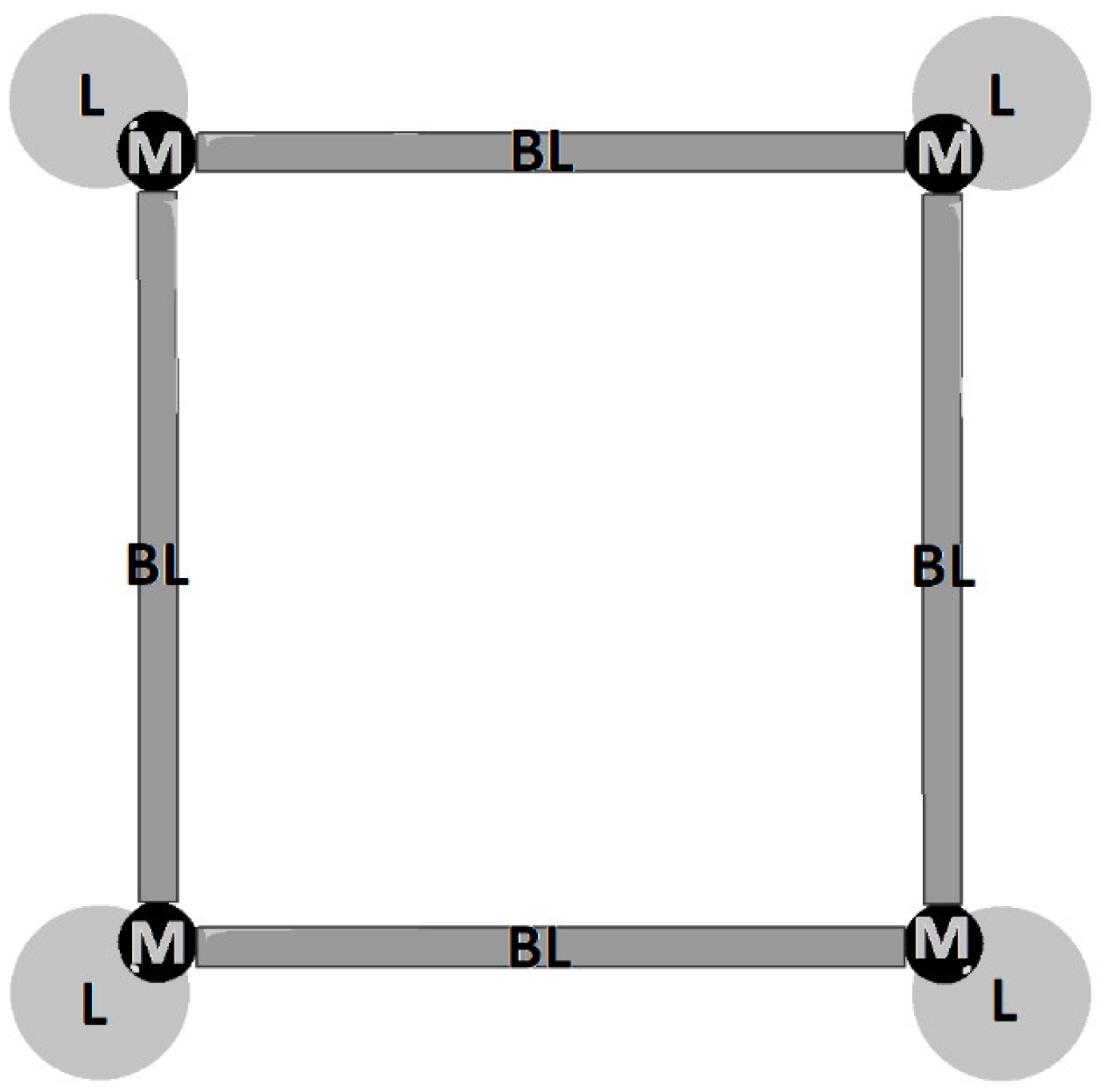
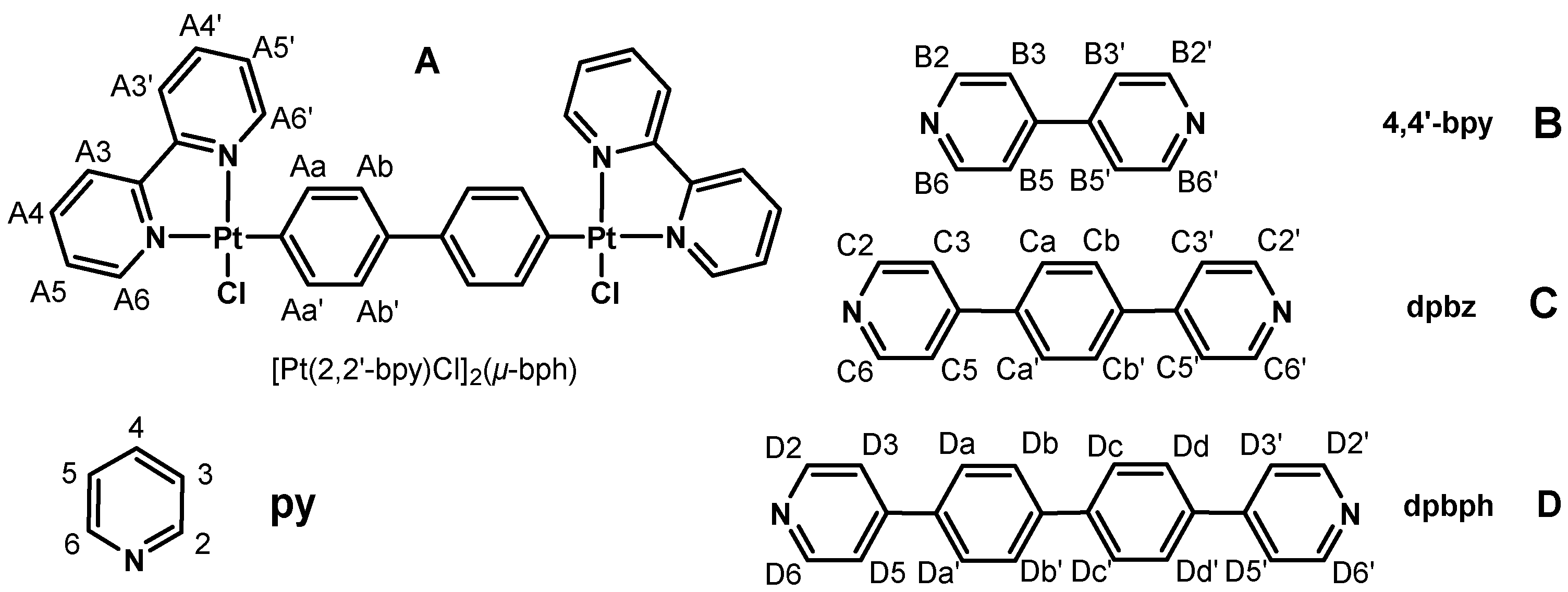



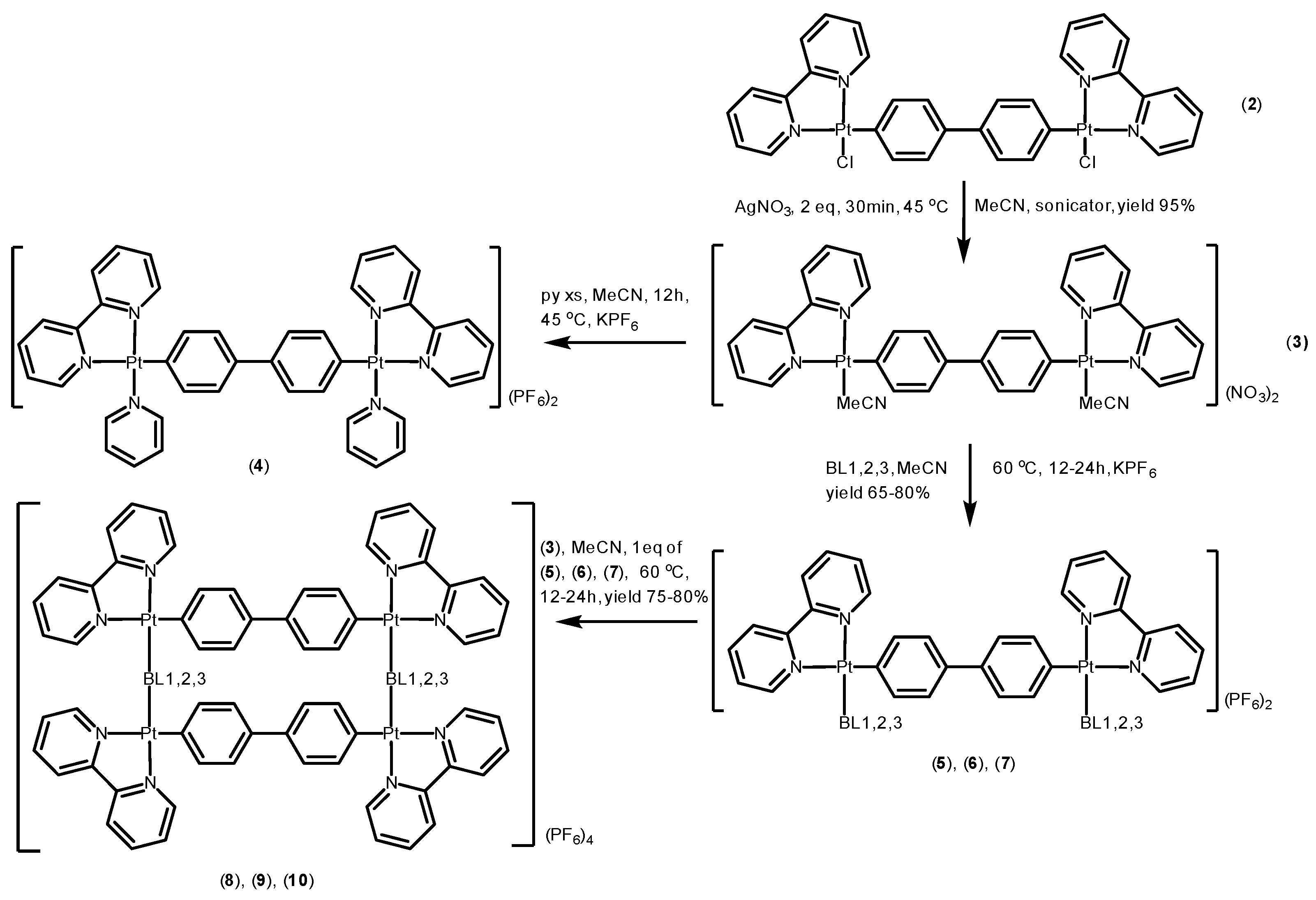
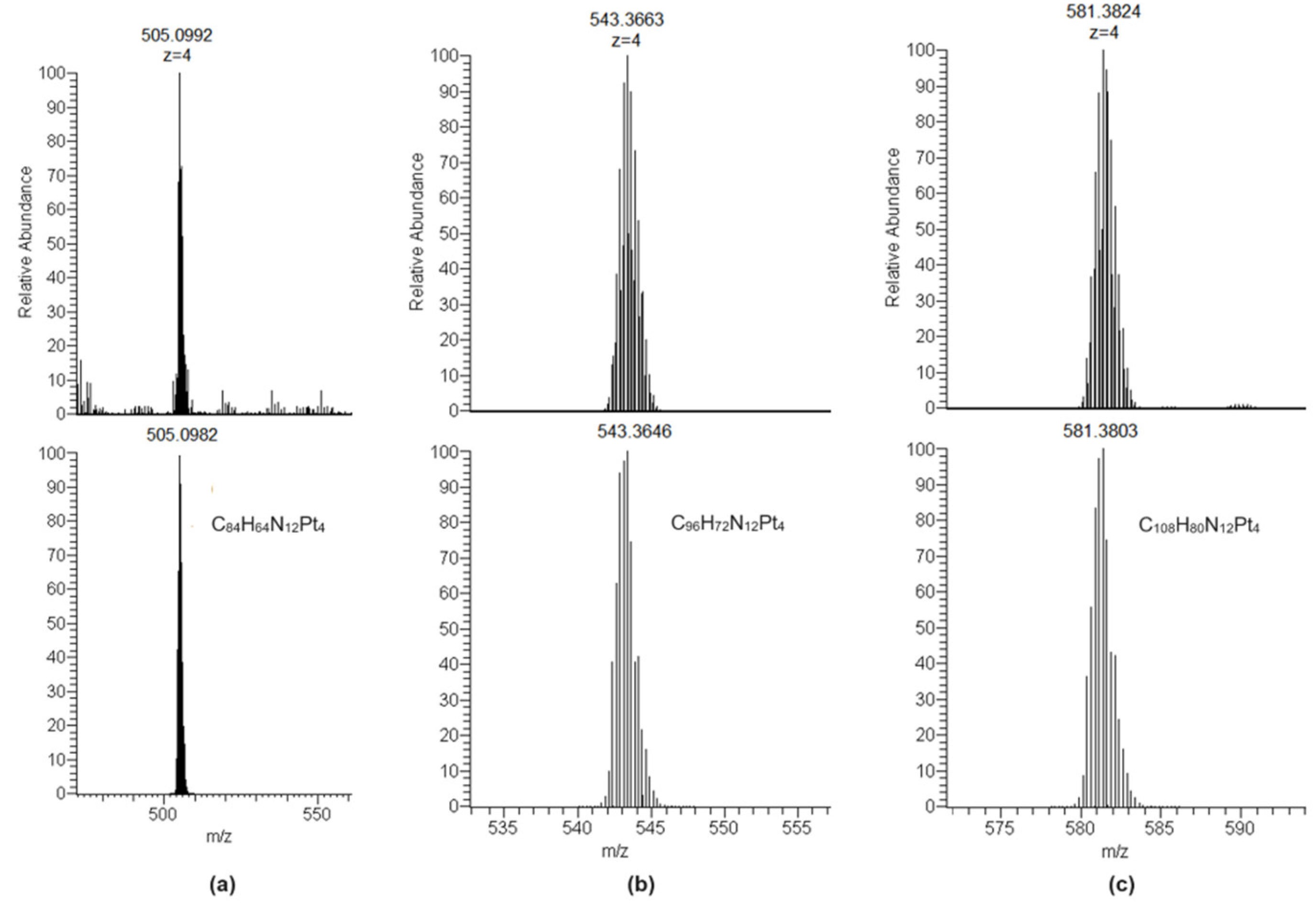
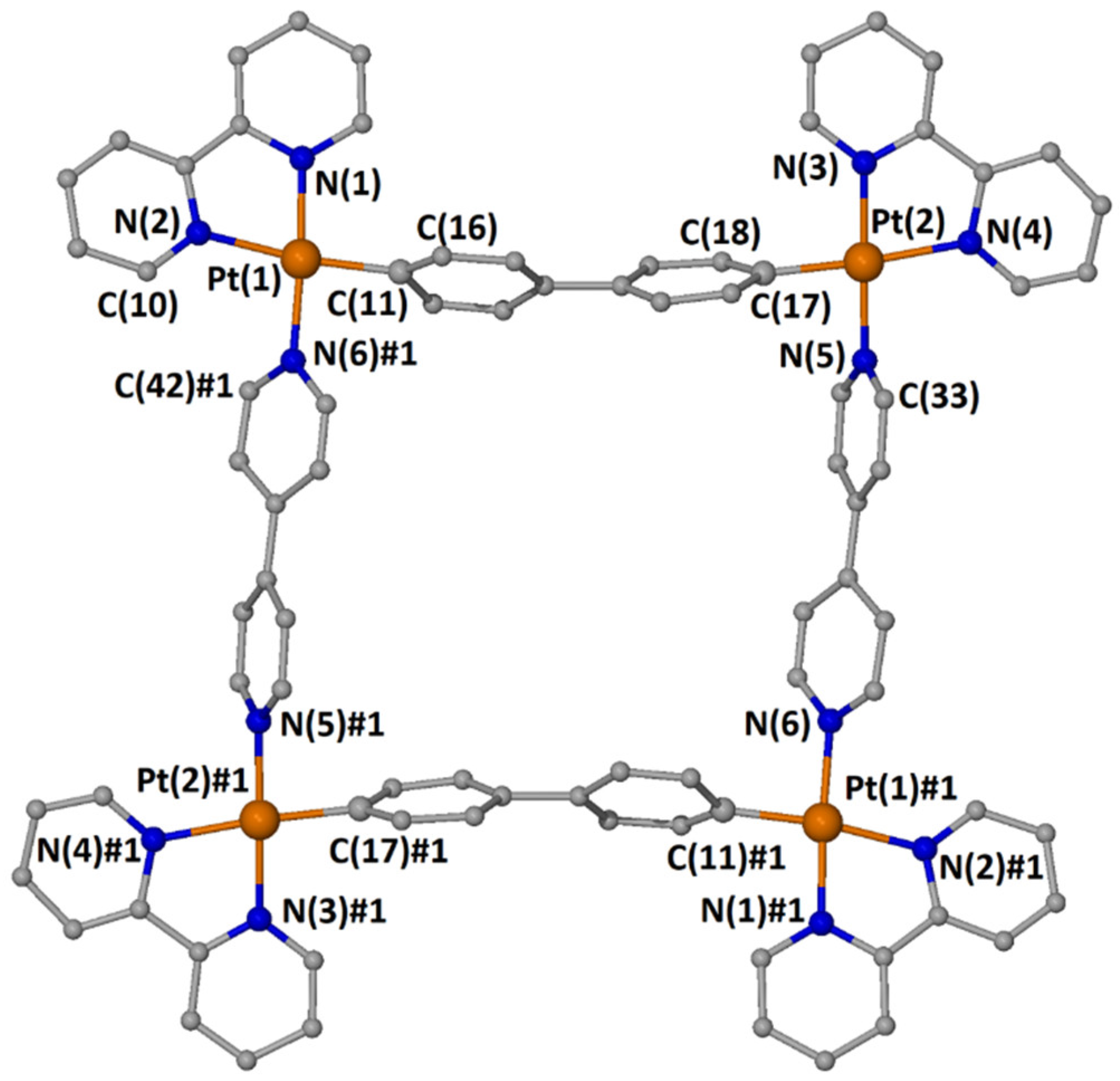


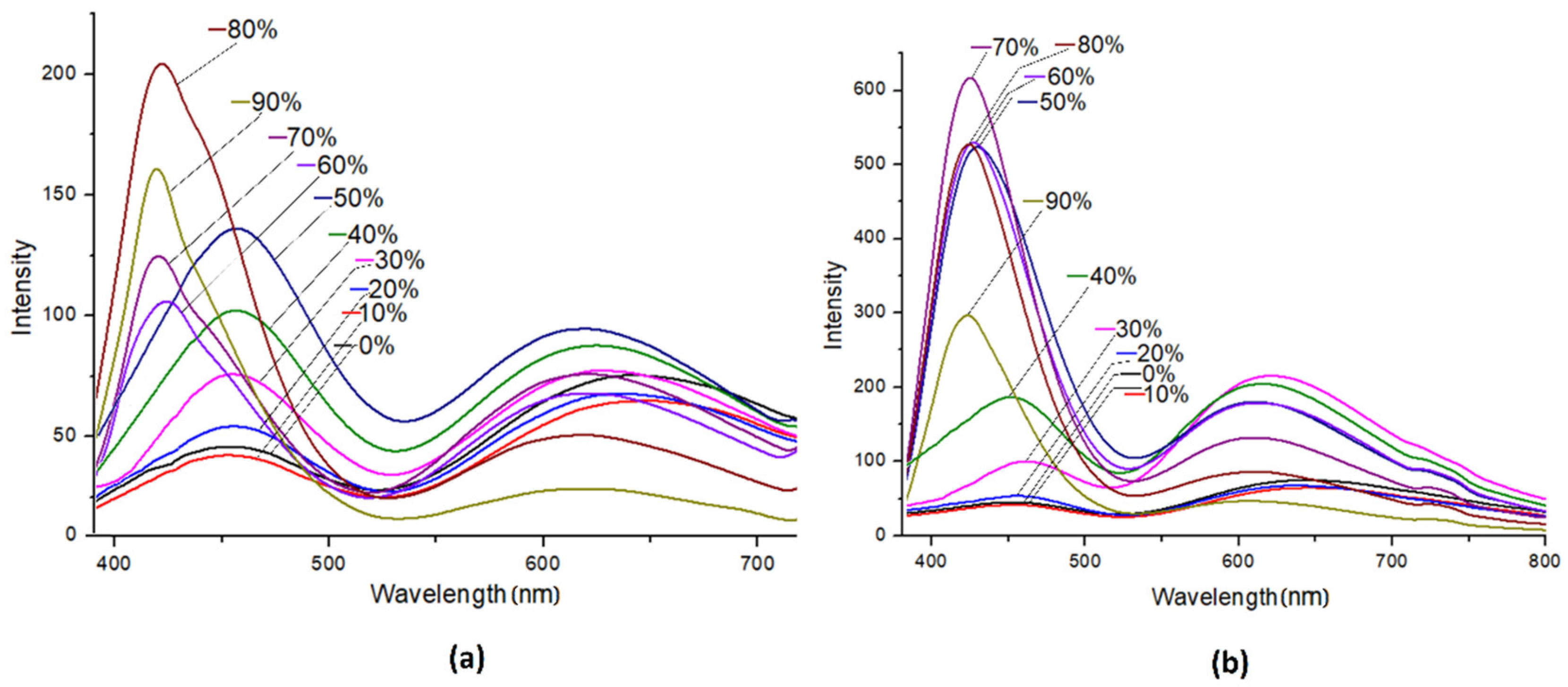
| Bond Lengths (Å) | |||
| Pt(1)–N(1) | 1.996(11) | Pt(1)–C(11) | 1.971(18) |
| Pt(1)–N(2) | 2.083(15) | Pt(2)–C(17) | 1.99(2) |
| Pt(2)–N(3) | 1.98(2) | Pt(2)–N(5) | 1.966(11) |
| Pt(2)–N(4) | 2.121(19) | Pt(1)–N(6)#1 | 2.009(17) |
| Pt(1)⋯Pt(2) | 11.086(1) | Pt(1)⋯Pt(2)#1 | 11.050(1) |
| Pt(1)⋯Pt(1)#1 | 15.124(2) | Pt(2)⋯Pt(2)#1 | 16.162(2) |
| Bond angles (°) | |||
| C(11)–Pt(1)–N(1) | 96.5(8) | N(5)–Pt(2)–N(3) | 178.3(7) |
| C(11)–Pt(1)–N(6)#1 | 87.4(8) | N(5)–Pt(2)–C(17) | 84.9(7) |
| N(1)–Pt(1)–N(6)#1 | 173.2(6) | N(3)–Pt(2)–C(17) | 96.0(9) |
| C(11)–Pt(1)–N(2) | 172.4(8) | N(5)–Pt(2)–N(4) | 100.0(7) |
| N(1)–Pt(1)–N(2) | 77.3(7) | N(3)–Pt(2)–N(4) | 79.1(9) |
| N(6)#1–Pt(1)–N(2) | 99.2(7) | C(17)–Pt(2)–N(4) | 174.4(8) |
| Pt(1)⋯Pt(2)⋯Pt(1)#1 | 86.20(1) | Pt(2)⋯Pt(1)⋯Pt(2)#1 | 93.80(2) |
| Complex | UV/Vis Absorbance λmax [nm], (ε × 104 [M−1cm−1]) | Excitation | Emission | QY% | ||||
|---|---|---|---|---|---|---|---|---|
| Solution (MeCN) | Solid | λexc | λem | |||||
| Solution (MeCN) | Solid | Solution (MeCN) | Solid | Solution (MeCN) | Solid | |||
| (8) | 273 (17.90) 312sh (11.2) 335sh (9.18) 363sh (2.20) | 225,275, 350, 440 | 365 | 400 | 646 | 602 | 0.04 | 1.1 |
| (9) | 295 (15.62) | 225, 280, 345, 420 | 365 | 400 | 667 | 581 624 (sh) | 0.08 | 1.2 |
| (10) | 315 (12.51) | 225, 280, 345, 420 | 365 | 400 | 685 | 577 | 0.14 | 6.0 |
| τ (10−9 s) | kr/(107 s−1) | knr/(107 s−1) | ||||
|---|---|---|---|---|---|---|
| τ1 | τ2 | kr1 | kr1 | knr1 | knr2 | |
| (8) | 4.85 | 34.07 | 0.82 | 0.17 | 19.8 | 2.82 |
| (9) | 9.65 | 34.04 | 0.83 | 0.23 | 9.53 | 27.0 |
| (10) | 6.93 | 38.57 | 2.0 | 0.36 | 12.4 | 2.23 |
| Solvent | λem (Φ %) | ||
|---|---|---|---|
| (8) | (9) | (10) | |
| DMF | NE | 614 (0.01) | 670 (0.22) |
| MeCN | 646 (0.04) | 667 (0.08) | 685 (0.14) |
| MeOH | NE | 659 (0.01) 455 | 630 (0.31) 461 |
| Acetone | 644 (0.02) | 622 (0.01) | 669 (0.58) |
| CHCl3 | 605 (0.01) | 592 (0.01) | 590 (0.13) |
| EA | NE | 598 (0.01) | 614 (0.48) |
| THF | NE | 602 (0.01) | 609 (0.02) |
| CH2Cl2 | 639 (0.01) | 604 (0.04) | 592 (4.09) |
| DE | 612 (0.01) | 598 (0.01) | 601 (0.12) |
Disclaimer/Publisher’s Note: The statements, opinions and data contained in all publications are solely those of the individual author(s) and contributor(s) and not of MDPI and/or the editor(s). MDPI and/or the editor(s) disclaim responsibility for any injury to people or property resulting from any ideas, methods, instructions or products referred to in the content. |
© 2023 by the authors. Licensee MDPI, Basel, Switzerland. This article is an open access article distributed under the terms and conditions of the Creative Commons Attribution (CC BY) license (https://creativecommons.org/licenses/by/4.0/).
Share and Cite
Garypidou, A.; Ypsilantis, K.; Plakatouras, J.C.; Garoufis, A. Dual-Emissive Rectangular Supramolecular Pt(II)-p-Biphenyl with 4,4′-Bipyridine Derivative Metallacycles: Stepwise Synthesis and Photophysical Properties. Molecules 2023, 28, 7261. https://doi.org/10.3390/molecules28217261
Garypidou A, Ypsilantis K, Plakatouras JC, Garoufis A. Dual-Emissive Rectangular Supramolecular Pt(II)-p-Biphenyl with 4,4′-Bipyridine Derivative Metallacycles: Stepwise Synthesis and Photophysical Properties. Molecules. 2023; 28(21):7261. https://doi.org/10.3390/molecules28217261
Chicago/Turabian StyleGarypidou, Antonia, Konstantinos Ypsilantis, John C. Plakatouras, and Achilleas Garoufis. 2023. "Dual-Emissive Rectangular Supramolecular Pt(II)-p-Biphenyl with 4,4′-Bipyridine Derivative Metallacycles: Stepwise Synthesis and Photophysical Properties" Molecules 28, no. 21: 7261. https://doi.org/10.3390/molecules28217261
APA StyleGarypidou, A., Ypsilantis, K., Plakatouras, J. C., & Garoufis, A. (2023). Dual-Emissive Rectangular Supramolecular Pt(II)-p-Biphenyl with 4,4′-Bipyridine Derivative Metallacycles: Stepwise Synthesis and Photophysical Properties. Molecules, 28(21), 7261. https://doi.org/10.3390/molecules28217261






